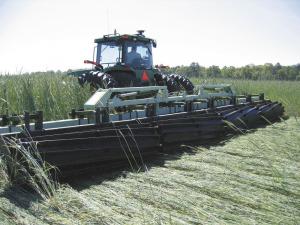2009 - Volume #33, Issue #1, Page #02
[ Sample Stories From This Issue | List of All Stories In This Issue | Print this story
| Read this issue]
Crop Rollers Make Cover Crops Work
 |
 |
"We had been using light cover crops for 15 to 20 years. But rye is a lot heavier," says Brooks, of Atmore, Alabama. "I probably overbuilt these rollers. They're so heavy, it's all I can do to tow them with my Deere 8520."
Cover crops are a big part of Brooks' cotton/peanut rotation. It keeps his sandy soil from blowing, shades out weeds, and builds organic matter. It also helps retain moisture. However, crushing the crop down into a mat is key. Brooks says his 40-ft. roller does the job.
"I used 7 by 7-in. square tubing, a folding Orthman toolbar, and four 10-ft. drums made from 24-in. cleated steel pipe," says Brooks. "With the Orthman bar's two wings, I can fold it up to a transport width of 20 ft."
The pipe sections were sealed with a shaft mounted on heavy-duty bearings inserted through each. Linkages between the drums and the toolbar were made from 2 by 3-in. steel tubing. Each section connects to the toolbar with bearings and pivot points, allowing them to float independently over the field. The cleats were made out 1/4-in., 4-in. wide flat stock welded with braces in a spiral around the pipe.
"The cleats give a good impression and let the drums run smoothly across the field, yet without chopping it up," says Brooks.
Each drum was originally designed to hold water should it be needed but Brooks has never needed it.
Randy Raper, ag engineer at the National Soil Dynamics Laboratory (NSDL), Auburn, Alabama, and other researchers have developed and patented multiple cover crop roller designs.
"Roller technology has long been used in South America, but they use rollers with horizontal bars pulled slowly across the field, often by animals," explains Raper. "North American farmers work at higher speeds. When one farmer tried a straight bar-type roller we made in 1999, he said it nearly shook him to death before it tore itself up from vibrations."
Since then the NSDL researchers have developed a roller with curved bars and also a smooth roller that's followed closely by a crimping bar that oscillates up and down to crush plant stems. A roller, with straight bars, was designed to be used at slower speeds on raised beds. Raper says vibration at the slower speeds isn't a problem.
The NSDL researchers compared the three rollers and found that all three flattened a rye cover crop and killed at least 90 percent of it within three weeks. However, the roller with the smooth drum and crimping bar was most effective. Adding an application of herbicide at every fourth crimp increased effectiveness to 98 percent.
"Historically we couldn't plant into these heavy cover crops, but these rollers make it possible," says Raper. "Down here, we are always just two weeks away from a drought due to our soil's poor water holding capacity. A heavy cover crop can gain our crops an extra 7 to 14 days of drought resistance."
Contact: FARM SHOW Followup, Jimmy Brooks, Brooks Farm, 287 School Rd., Atmore, Alabama 36502 (ph 251 862-2384; jb@brooksfarm.net) or Randy Raper, National Soil Dynamics Laboratory, 411 South Donahue Dr., Auburn, Alabama 36832 (ph 334 844-4654; fax 334 887-8597; randy.raper@ars.usda.gov).

Click here to download page story appeared in.

Click here to read entire issue
To read the rest of this story, download this issue below or click here to register with your account number.




